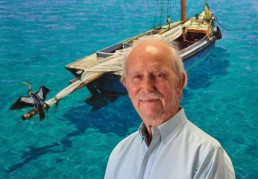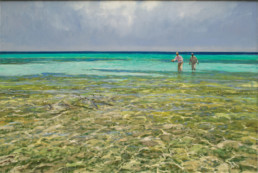By Fred Polhemus

Al Barnes in front of one of his paintings, Fore & Aft.
Image provided by Fred Polhemus.
Al Barnes (1937–2015) is widely acknowledged as one of the premier sporting artists of our time. He is considered the foremost expert and artistic master of flats subjects, and his distinguished career in this genre spanned almost forty years until his passing late in 2015. Barnes spent thousands of hours in pursuit of game fish in some of the most beautiful flats settings in the world.
With a deft hand and masterful eye, Barnes drew from firsthand experiences to convey on canvas the water’s blues and greens, shimmering reflections and light bars, changing colors, and cloud shadows. In his vast panoramas of sky and water, Barnes painted the angler in pursuit as a relatively minor element, conveying the individual’s insignificance in a large and majestic place. This is how Barnes saw himself in such settings: a minor detail in a grand production.
The main source of inspiration for the majority of Barnes’s paintings was the Caribbean, the Bahamas, Belize, the Keys, or any other number of beautiful thin-water settings, but he was equally at home in the coastal marshes of his native South Texas. From bonefish tailing on the flats to pintails lifting off a tidal marsh, water—and his unique treatment of it—is the common factor in his paintings.
Barnes was born in 1937 and raised in Texas. His parents were restaurateurs in Port Isabel, not far from South Padre Island. This was heaven for Barnes, who loved to fish as much as he loved to paint. He spent a lot of time on Padre fishing and walking the beaches. He learned to sail and would often ride on commercial fishing boats to various locations. In his youth, he spent a lot of time on boats and at the easel, balancing both passions.
Barnes pursued classical training in school, learning how to draw and paint. This included drawing nudes—the best way for painters to learn figure drawing. The formal training also broadened his art horizons in general and taught him how to make a living at it. He studied art history and learned much from the painters who came before him.
Barnes spent a dozen or so years after college in various apprenticeships. He did commercial art in Dallas, sharpening his skills, refining his technique, and creating his own style until his yearning for salt water drew him back to the Gulf Coast. Leaving Dallas to return to his roots, Barnes bought a small beach house near Corpus Christi in the late 1960s and started painting shrimp boats and sailboats, coastal scenes and seascapes. His marine paintings were the staple of his fine-art creations—that is, until he took up saltwater fishing again, chasing redfish, trout, drum, sailfish, and marlin off Texas, the Mexican Yucatán, Hawaii, and Belize.
He began painting underwater scenes of cruising and schooling fish, both pelagic and thin-water subjects, which drew him more to the shallows, to the Texas saltwater marshes, the Florida Keys, the Bahamas, and the Caribbean. He started painting flats fishing from an above-water perspective, depicting both the fish under the water and the angler above it. His paintings are washed in cobalt turquoise, the color of many Caribbean flats, where he often went to fish and gather new material.
Barnes didn’t paint in situ but rather took extensive photos and notes of the water, sky, beach, fish tailing, and anglers in pursuit. The creative process took place in his studio, with studies for values, composition, and color combinations. From these studies, he created the finished works, sometimes in watercolor but most often in oil.
The artist painted what he knew. He knew the fish, the tackle, and the flats boats. He knew how the anglers work from the boat or in the water, how an angler approached his or her prey, and how the take could create the memory of a lifetime.
During his long and distinguished career, Barnes achieved many milestones, and the accolades were countless. As recently as the year before he passed away, Barnes received a lifetime achievement award from the Harvey Weil Foundation of Corpus Christi (an organization supporting ongoing sportsman conservation efforts). He was a National Ducks Unlimited Waterfowl Artist of the Year, two-time Texas State Ducks Unlimited Artist of the Year and Coastal Conservation Association Stamp Artist, three-time Texas Saltwater Stamp Artist, and two-time International Game Fish Association featured banquet artist. His work has been featured in magazines such as Sporting Classics, Gray’s Sporting Journal, Southwest Artist, Florida Sportsman, Marlin Magazine, and Artist Magazine. Barnes had numerous one-man and group exhibitions to his credit, and his work is featured extensively in private and corporate collections around the world, including the National Wildlife Museum in Jackson Hole, Wyoming, and the American Museum of Fly Fishing.

Will They Eat?, an oil painting by Al Barnes. From the collection of the American Museum of Fly Fishing.
This article first appeared in the Winter 2017 (Vol. 43, No. 1) issue of the American Fly Fisher.

